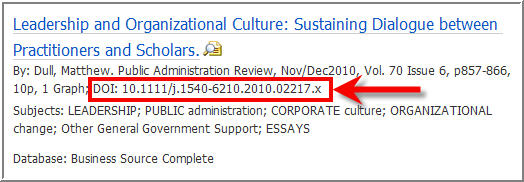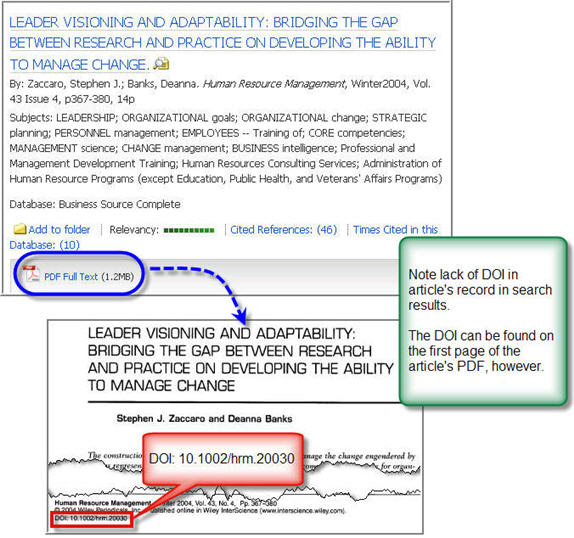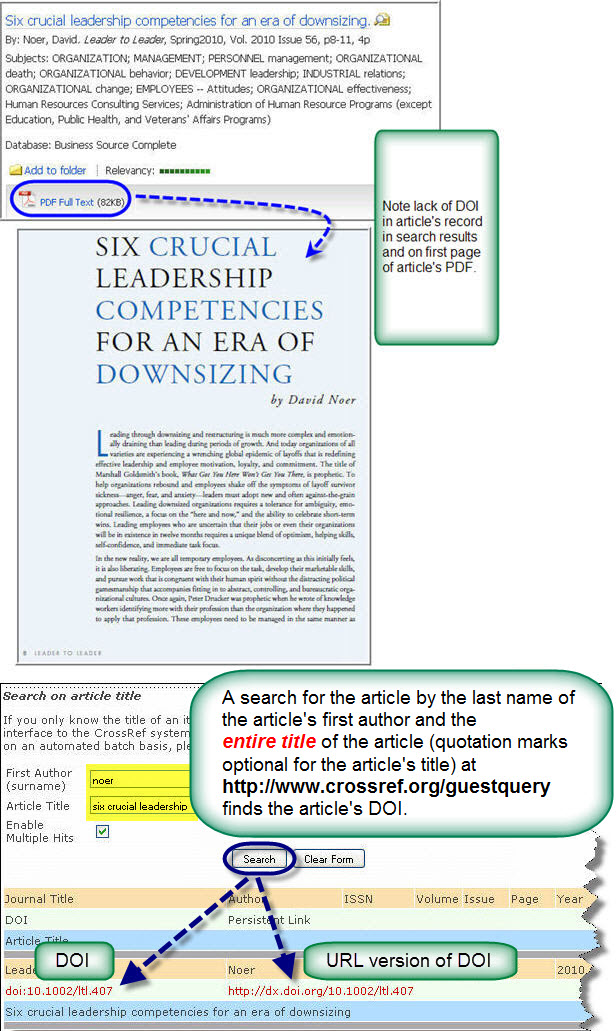


Per the seventh edition of the APA Publication Manual, you should provide an article's DOI at the end of your reference list citation if the article that you're citing has a DOI, regardless of whether you found or read the article online or in print. If you're citing an article that doesn't have a DOI, your citation should end after the article's page range; there's no need for a retrieval statement or URL at the end of your citation.
This page provides information that will help you correctly cite articles in APA style. The following topics are covered:
"DOI" stands for "digital object identifier." A DOI is an alphanumeric string (meaning that it may contain letters and/or numbers) that can be used to uniquely identify an online journal article or an online book chapter, etc.
Since 2000, many publishers around the world have assigned DOIs to documents when the documents are published and made available online. DOIs help to ensure that documents will be findable over time, regardless of what database they can be found in or where they're saved online.
Not all publishers participate in the DOI initiative, however, and so not all online documents have a DOI.
Also, it's worth noting that some publishers have been retroactively assigning DOIs to articles, so you may come across some articles published before 2000 that have a DOI assigned to them.
All DOIs begin with 10. followed by four numbers and then a slash followed by a string of letters and/or numbers, as in the following examples:
10.1093/jopart/muq015
10.1111/j.1540-6210.2010.02217.x
10.4102/sajhrm.v7i1.175
Beginning in Fall 2011, some DOIs have been displayed as URLs, with the prefix http://dx.doi.org/ appearing before the DOI, as in the following examples:
http://dx.doi.org/10.1093/jopart/muq015
http://dx.doi.org/10.1111/j.1540-6210.2010.02217.x
http://dx.doi.org/10.4102/sajhrm.v7i1.175
As of March 2017, the URL format was revised to use https: rather than http: and to remove the dx before doi.org, as in the following examples:
https://doi.org/10.1093/jopart/muq015
https://doi.org/10.1111/j.1540-6210.2010.02217.x
https://doi.org/10.4102/sajhrm.v7i1.175
The most recent format (from March 2017) is the current preferred format for DOIs.
The four numbers after the 10. identify the publisher associated with the DOI, while the string of letters and/or numbers after the slash is assigned by the publisher. There's no set format for the way the string of letters/numbers after the slash should appear, so some articles will have very short DOIs while others will have much longer ones, and some will have DOIs consisting of just letters while others will have DOIs consisting of just numbers and still others will have a mix of letters and numbers.
Any number that begins with something other than 10. followed by four numbers and a slash and then a string of letters and/or numbers is not the article's DOI.
"ISSN" stands for "international standard serial number." ISSNs uniquely identify a serial publication (journal, magazine, newspaper, etc. -- "serial" refers to something that's published at regular intervals). ISSNs don't, however, identify the content of a periodical; an ISSN can't be used to identify a specific article.
ISSNs are 8 digits long; they consist of 4 digits followed by a hyphen and then 4 more digits -- for example: 1545-9993.
More information about ISSNs can be found at What is an ISSN?
An ISSN is not the same thing as a DOI, and ISSNs should not appear in APA citations.
An accession number (known in some databases as a document ID number) uniquely identifies an article within a particular database only. An accession number is assigned to an article by someone who works for a database vendor. The accession number generally reflects the order in which the article was added to the database. Because accession numbers are database-specific, you need to know which database an accession number came from in order to search for an article by its accession number.
An accession number/document ID number is not the same thing as a DOI, and -- except in the case of dissertations and theses, as noted on p. 334 of the seventh edition of the APA Publication Manual -- accession numbers/document ID numbers should not appear in APA citations.
Return to topIf an article has a DOI, it can be found in one of three ways. To look for an article's DOI:



Note that your instructors may not require you to use http://www.crossref.org/guestquery to determine whether an article has been assigned a DOI; many instructors just require students to check databases and PDFs for DOIs.
The seventh edition of the APA Publication Manual says that citations for any article with a DOI should end with the article's DOI, in the following format: https://doi.org/xxxxxxx (where xxxxxxx should be replaced by the actual DOI information). If the source that you're citing has a DOI written in a different format, you should amend the DOI as needed so that it is written in the current recommended format.
Since DOIs may be quite long, it's recommended that you copy and paste them from your source into your citation, so that you can avoid possible typos.
The APA does say, though, that when DOIs are particularly long or complex, it's OK to use a shortened DOI. The International DOI Foundation offers a DOI shortener tool at http://shortdoi.org that can be used to generate unique shortened DOIs.
The APA says that you shouldn't manually add a line break to a long DOI, although it's OK if your word processing program automatically breaks a DOI up or moves it to its own line.
The APA also says that it's OK for DOI URLs to be either underlined and in blue font (recommended if what you're writing will be read online) or in the default black non-underlined font that the rest of your text is written in.
Here is a sample citation for an article with a DOI:
Davis, E. B., Kee, J., & Newcomer, K. (2010). Strategic transformation process:
Toward purpose, people, process and power. Organization Management
Journal, 7(1), 66-80. https://doi.org/10.1057/omj.2010.6
As mentioned earlier, the seventh edition of the APA Publication Manual says that when an article doesn't have a DOI, your citation should end after the article's page range.
Bellamy, K. (2010). Frame breaking leadership. Integral Leadership Review,
10(3), 1-12.
Very few UMGC Library databases currently allow you to search for an article by DOI. (Databases that do currently allow this include ACM Digital Library, PsycARTICLES, PsycINFO, ScienceDirect, and Scopus. To find an article by DOI in any of these databases, copy and paste the article's DOI into a search box in the database and use the drop-down menu next to the search box to select the entry for DOI.)
In general, though, if you have an article's DOI, the easiest way to find the full text of the article is to enter the DOI in the DOI resolver box provided at http://www.crossref.org, which will give you the article's citation:

Once you have the article's citation, you can see whether the full text of the article is available online in a UMGC Library database by following our instructions for Finding Articles from a Specific Journal.
Return to topIf you have any questions about this information, please use the UMGC Library's Ask a Librarian service to receive assistance.